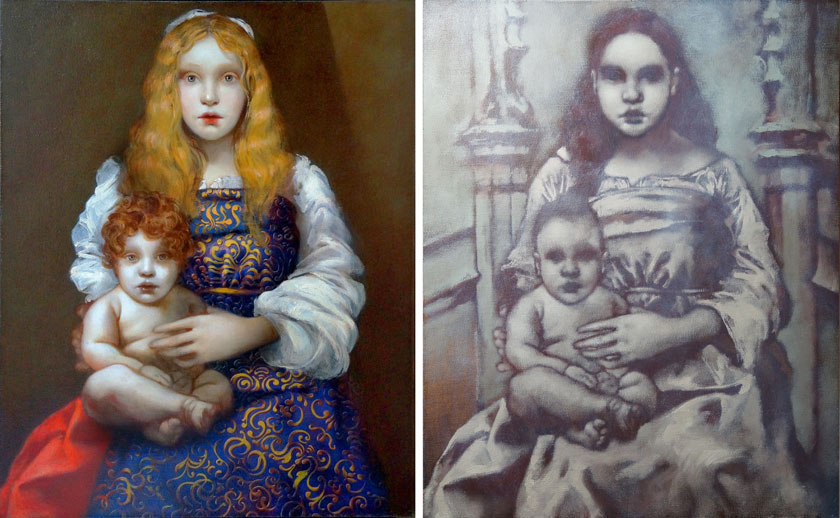Art Lesson 42, Part 2
How to do Grisaille Underpainting Using Dry Brush Method
Learn how to paint like the Old Masters!
Old Masters Academy Online Course
Self-study, self-paced online video courseLifetime membershipOne-time payment: $487Enroll Now!Personal Tutoring online + Online Course
Unlimited tutoring by the Academy teachersLifetime membershipOne-time payment: $997Enroll Now!« Back to the Art Lessons List
Grisaille Underpainting Using Dry Brush Method
We will continue Session One while the brown Brush Sketch is still wet. For this step, we are using undiluted Titanium White oil paint, straight from the tube.
In lighted areas, the White remains white. In halftones, you can mix it with the brown paint on the Sketch. In the darker shades, leave the brown Sketch untouched. The skin of the face should be painted more smoothly than the fabric. Apply the Dry Brush method more densely in the more illuminated parts and spread thinly in areas with half tones.

The neckline area also should be painted gently when spreading the paint. The shadow area under the head can be softened by spreading White over a brown Sketch that is still fresh. The Dry Brush method, with a small amount of paint, allows two colors slightly intermix.
We apply the same treatment to the Underpainting of the hand. The paint should be spread thinly over the surface, using the Dry Brush method (No Medium is required).
Do not apply the coat of paint too thickly. Let the Imprimatura show through the paint layer.
To emphasize different textures, we will make the dress appear to be made from dense material. That’s why we paint the fabric more roughly than the skin.
Sleeves are made from softer fabrics, so we will paint thinner, loose folds that envelope the arm. The skin of the infant should be painted as smoothly as the skin on Madonna’s face. We apply the paint, then smooth it out evenly, all around. Keep the brush dry while spreading the paint. Remember, the Dry Brush method doesn’t require any Medium.
The folds of the dress are large and roundish as the fabric is thick. In wide areas, rub paint into the canvas with a large-sized Hog Brush. More opaque brush strokes can be applied with a smaller Brush to highlight fabric folds.
Now, we fill in the remaining areas. That is it for the first session.
Session Two
We continue after the first layer of the Underpainting has completely dried. We are using Titanium White directly from the tube without adding any additional Medium. Now we increase the whiteness of the Underpainting and also increase the volume of the paint layer. As before, we use the Dry Brush method. We repeat the same process for the child’s figure.
As we overpaint the completely dry surface, the white paint does not intermix with the previous layer. Vary the thickness of the layer; thicker in light areas and thinner in halftones. Leave shades untouched at this stage. With the hand, we do exactly the same thing: build up the volume and whiteness.
For the fabric, we apply a thicker coat of paint and work more loosely with our brush.
The same principles are applied here – highlights are more opaque. For midtones, paint is spread thinly and shade areas remain untouched.
For the background, we mix Titanium White and a bit of Mars Black to make the paint cooler. No Medium is added. This is how the painting looks after a second coat of Grisaille.
Session Three
The painting was left to dry for about two weeks as Whites are long- drying paints. Now we can continue.
For the next step, we will use a semi-opaque Zinc White, diluted in Turpentine. Spread the paint evenly, all over the canvas. This creates a haze effect and minimizes the contrast between lights and shades. Now we can put the painting aside to dry.
Session Four
We continue over the completely dry surface. Highlights are reinforced with an opaque Titanium White. Now we work on the details, using the Dry Brush method with no Medium added.
Facial features can be outlined with more detail. For this purpose, we mix Venetian Red and Mars Black without any Medium. Now we have finished the Underpainting.




